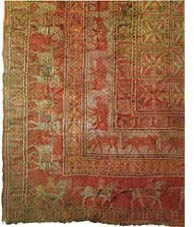Pazyryk Rug - Oldest rug ever discovered
Persian Rugs are the oldest, most creative and unique rugs in terms of designs and quality in the world.The art of pile rug weaving appeared in Europe some time after 1000 AD, and likely in Spain because of its proximity to Egypt, Mesopotamia, and Iran.Rug weaving in Europe never became as important as it did in Asia and as a result, many Asian nations built enormous rug exporting industries over time. Before 1947 the oldest rug ever discovered was found in East Turkmenistan in an area known as the Tarim Basin, and in 1947 Russian Archaeologist Sergei Rudenko made a major discovery which had a dramatic impact on the artistic history of rugs. Mr. Rudenko found what is now considered to be the oldest rug in the world ever found.

The Pazyryk (a Persian Rug) was discovered in ice filled tomb in Outer Mongolia (Scythian burial mound) dating from the 5th Century BC. It has all the Characteristics of a modern Persian or Anatolian with a Pile and Ghiordes knots. The rug has a central field surrounded by major and minor borders. The central field has a madder red ground upon which are rows of squares containing schematised floral motifs. The squares are themselves contained within a border of octagons resembling later Turkoman (ghiordes) 300 asymmetrical knots per square inch.The Pazyryk rug shows a mixture of Assyrian, Achaemenian (ancient Persian empire), and Scythian motifs, and it is believed by some to be of Persian origin. Most believe it was woven by nomads who migrated to this area from the region known today as Mongolia, or they wove it in farther east regions and brought it westwards.The History and evidence available proved that the best and oldest Rugs known to be originated from Persia and then moved towards Anatolia, West of China and Mongolia. The Persian are mother of designs , colours and weaving. The first rug ever woven was between four to six thousand years ago in Persia.Mongolian also were amongst first nation to weave the pile rugs, but certainly the Persians were the first nation who took the rugs weaving craft and made it into an art form.The element of luxury with which the Persian carpet is associated today provides a marked contrast with its humble beginning among the nomadic tribes that at one time wandered the great expanse of Persia winters of the country. But out of necessity was born art. It was an article of necessity to protect the tribes from the bitter cold.
Rugs continue to play a significant role in the artistic traditions of cultures around the globe, from the geometrically complex Ayacucho designs of Peru, to the wildly contemporary sisal rugs of Brazil, to the intricate floral motifs of Indian Kashmiri rugs, to the world famous Persian rugs of Iran.
Interior designers often recommend area rugs as the fastest and simplest design element available to totally reinvent a room or to revitalize existing décor, while at the same time providing warmth and depth, sound absorption, and floor surface protection.The Pazyryk Rug is kept at the St. Petersburg museum in Russia and is part of their permanent exhibiting item.

The Pazyryk (a Persian Rug) was discovered in ice filled tomb in Outer Mongolia (Scythian burial mound) dating from the 5th Century BC. It has all the Characteristics of a modern Persian or Anatolian with a Pile and Ghiordes knots. The rug has a central field surrounded by major and minor borders. The central field has a madder red ground upon which are rows of squares containing schematised floral motifs. The squares are themselves contained within a border of octagons resembling later Turkoman (ghiordes) 300 asymmetrical knots per square inch.The Pazyryk rug shows a mixture of Assyrian, Achaemenian (ancient Persian empire), and Scythian motifs, and it is believed by some to be of Persian origin. Most believe it was woven by nomads who migrated to this area from the region known today as Mongolia, or they wove it in farther east regions and brought it westwards.The History and evidence available proved that the best and oldest Rugs known to be originated from Persia and then moved towards Anatolia, West of China and Mongolia. The Persian are mother of designs , colours and weaving. The first rug ever woven was between four to six thousand years ago in Persia.Mongolian also were amongst first nation to weave the pile rugs, but certainly the Persians were the first nation who took the rugs weaving craft and made it into an art form.The element of luxury with which the Persian carpet is associated today provides a marked contrast with its humble beginning among the nomadic tribes that at one time wandered the great expanse of Persia winters of the country. But out of necessity was born art. It was an article of necessity to protect the tribes from the bitter cold.
Rugs continue to play a significant role in the artistic traditions of cultures around the globe, from the geometrically complex Ayacucho designs of Peru, to the wildly contemporary sisal rugs of Brazil, to the intricate floral motifs of Indian Kashmiri rugs, to the world famous Persian rugs of Iran.
Interior designers often recommend area rugs as the fastest and simplest design element available to totally reinvent a room or to revitalize existing décor, while at the same time providing warmth and depth, sound absorption, and floor surface protection.The Pazyryk Rug is kept at the St. Petersburg museum in Russia and is part of their permanent exhibiting item.


<< Home